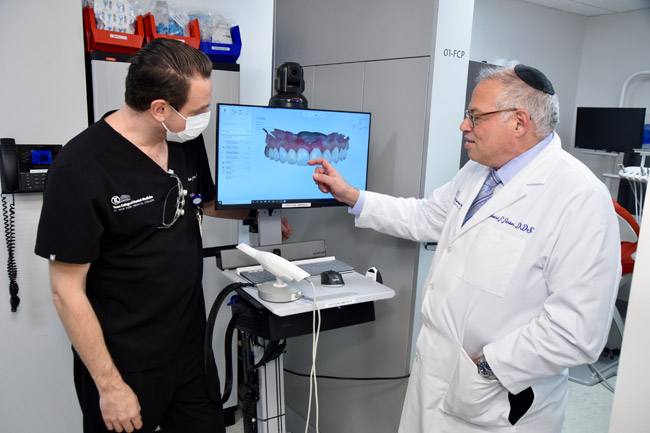Touro Dental leading students to the digital forefront of the field
Every educator has been facing the challenges of putting digital tools to work in the teaching environment. At the Touro College of Dental Medicine in Valhalla the challenge has been exponentially greater because dentistry itself has been making a fundamental transition to the digital world.
The transition involves more than just replacing manual patient records and billing with computerized systems or installing digital X-ray devices. The digital dentistry revolution includes full-mouth scanners, computer-controlled milling machines, 3-D printers and more.
“We are adding machinery and software that allows us to do things in ways that we were not able to do before and at the same time produce a more precise and predictable result,” Dr. Edward F. Farkas, vice dean and professor of dental medicine at Touro told the Business Journal.

Touro has opened a new digital dentistry lab on the third floor of its building at 19 Skyline Drive, adjacent to its teaching clinic, Touro Dental Health. The hardware, specialty software and technology system that includes patient records is integral to training students while enhancing the affordable dental services being offered to members of the public. Dr. Alan Jurim is the director of digital dentistry at Touro.
Farkas said that the transition to digital dentistry has seen digital scanners replace impression material that had to be placed in a patient’s mouth, 3-D printing to make prostheses such as dentures, milling machines that can, for example, take a block of zirconia and form it into desired shapes, specialized X-ray systems and suites of software for use in planning procedures and telling the machines what to do.
Farkas said that digital dentistry enables practitioners to preplan procedures to an extent not previously possible and consistently produce precise results. For the school, the transition has involved not only installing equipment and software but also developing a curriculum using digital tools to teach all about the devices being introduced.
“Most students are digitally savvy,” Farkas said. “They basically understand the basics of the software but the software does have many, many layers to it and it does take a lot of time to master it.”
He said, for example, that when using digital tools for planning an implant, students are given an X-ray and know the space where the implant needs to fit. They have to plot the dimensions of the implant, at what angle it needs to be placed, how deep it can go and whether there are any vital structures nearby that need to be considered.
“As the students are actually using the software, they”™re learning about implant placement. The software, by making them think about the different possibilities, is actually teaching them about implant insertion,” Farkas said.
“Most of these tools were invented for the private practice world. They were never really meant to be able to be used by 110 students at a clip. Obviously the computing power and the information technology setup necessary for that had to be constructed from scratch and we are very fortunate to have a great IT team that was able to do it,” Farkas said.
Farkas said that they invited Tais Clausen, then CEO of 3Shape, a company based in Copenhagen that manufactures scanners, software and other digital dentistry components to visit Touro.
“He was kind of amazed to see what we had done with his software, putting it onto a server system so that students could use it throughout the clinic. He said to me, ”˜That never was our intent to be so widely distributed on a network,”™ but he was taken aback that what he had invented was so widely used in the clinic,” Farkas said.
“I remember we were walking through the clinic and a student was using one of his scanners and he stopped and went over to the student and said, ‘
”˜Let me show you how to do it. You have to hold it like this and like that.”™ Imagine, the guy who invented a scanner and is world-famous for doing it and whose company is at the forefront of digital dentistry teaching one of our students how to scan. I think that moment is precious.”
Farkas said that teaching the use of digital resources is a necessity now in dental education.
“This is being driven by the demands of the real world. What these machines do is make the treatment go faster, smoother, more precise. In some cases, the kind of treatment would not exist without the machines,” Farkas said.
He said that extensive treatments, such as crafting all new dentures to replace a person’s teeth that used to take many months can now be done in a matter of days.
“The digitization of dentistry and the school’s adaptation of it attracts new students. There”™s no question about it. If you want to learn digital dentistry, Touro College of Dental Medicine is the place to do it. We are attracting the best and the brightest of the potential applicant pool and we are initially retaining a large portion of that in the class,” Farkas said.
“We accept about 114 students a year. Students who are accepting our invitations to participate in our class are keeping them because they know that this is the place where they”™ll get the highest level of digital education.”